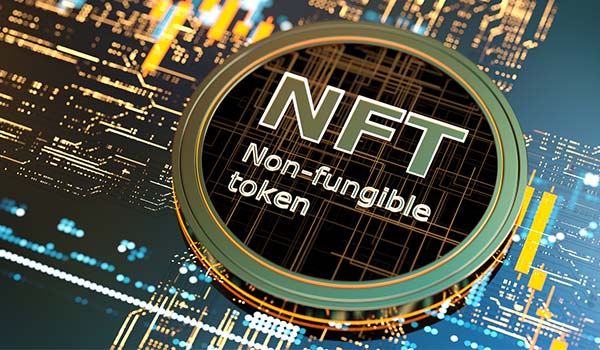06-1-2022 |
Is an NFT Intellectual Property?
By: Jordan Meggison-Decker

The terms “NFT”, “bitcoin”, “blockchain”, and “cryptocurrency” have exploded in the last few years. From brands using NFTs as promotional opportunities to creators using NFTs to monetize their content, these terms are rampant. Although they can be confusing, each term has a specific meaning which indicates how it works and how it can affect businesses from a legal standpoint. In this article, we hope to familiarize these terms and provide an overview of how they are associated with important legal rights.
NFTs and Intellectual Property
First, it is helpful to understand what NFTs are and how they are related to other cryptocurrencies. The acronym “NFT” stands for non-fungible token. The term “non-fungible” means that each NFT is unique or one of a kind. Because they are non-fungible, NFTs are different from fungible cryptocurrencies like Bitcoin. Bitcoin is fungible because it is possible to trade one Bitcoin for another Bitcoin while one NFT cannot be traded for another NFT. Additionally, NFTs are associated with digital assets by a process called minting. Digital assets include things like digital artwork, drawings, tweets, music, videos, trading cards, etc. After a digital asset is minted with an NFT, the digital asset is forever recognized as the original digital asset.
NFTs prove the originality of a digital asset using a blockchain. Specifically, NFTs use a blockchain to keep track of digital assets. A blockchain is a database or a collection of information stored electronically on a computer system. A blockchain database collects information and groups it into blocks. As new data is entered into the database, blocks fill and new blocks are created. The blocks of information link to each other and create a chain. When a new block is added to the chain, it is given an exact timestamp. This blockchain system can go on forever and the timeline that is created is irreversible, reliable, and accurate. As such, NFTs can prove that the digital asset they are attached to is original because they are backed by reliable information on the blockchain.
An NFT’s value comes from the fact that each one is unique and is linked to an original digital asset. Specifically, it is not possible to have multiple NFTs on one digital asset, each NFT represents an original and unique asset. Therefore, an NFT can function as a limited-edition certificate of authenticity. This means that the NFT owner can verify that they own the original digital asset. When artwork is proven to be an original Monet, Picasso, or Rembrandt; it is worth much more than a copy of the same artwork. Similarly, NFTs represent original versions of digital assets, and proving that a digital asset is an original adds value to the digital asset.
The value NFTs provide is attractive to both creators and collectors, however, it is worthwhile to understand how legal rights may be implicated by using NFTs before purchasing or creating one. One group of legal rights that may be implicated is intellectual property rights. Intellectual property is a type of property that protects an individual’s intangible creations or inventions. This property can be protected using copyrights, patents, trademarks, or trade secrets. The specific type of protection sought depends on the type of creation that is being protected, but the three main types of intellectual property which may interact with NFTs are copyrights, patents, and trademarks.
NFTs and Copyrights
Copyrights are a type of intellectual property that protect original works of authorship that are fixed in a tangible medium. Copyrights may protect books, poetry, movies, songs, computer software, architectural blueprints, and artwork from being copied. When an author or artist creates an original work, they automatically hold the copyright to that work. As such, any other individual who wants to copy the author’s work must ask the author for permission.
Digital artwork is one example of a work that may be associated with both a copyright and an NFT. When digital artwork is created, it is protected by a copyright that is owned by the author of the digital artwork. Further, an NFT can be added to the digital artwork to identify it as an original. However, when the NFT covering the digital artwork is purchased, the copyright protecting the digital artwork is not automatically included in the transaction. The NFT purchaser may only acquire a non-exclusive license to display the copyrighted work while the copyright owner retains the rest of the rights granted by their copyright. This limited transfer could lead to problems down the road. For example, an NFT owner could be liable for copyright infringement if the NFT owner posts the digital artwork and violates the copyright owner’s rights.
NFTs and Trademarks
The ever-increasing use of NFTs could also raise trademark concerns. Trademark registrations are awarded to trademarks that are being used in commerce and that are not confusingly similar to other trademarks. Trademark rights allow users to preclude others from using their trademarks. Therefore, NFT creators should be wary of using trademarks within a digital asset covered by an NFT. If trademarks are incorporated into a digital asset covered by an NFT, the owner of the trademark may require that the trademark be removed from the asset. As such, before creating an NFT, it is helpful to consider the content of the NFT and whether it can be used. On the opposite side, trademark owners should be vigilant that NFTs do not use their trademarks without permission.
NFTs and Patents
Patents are awarded to those subject matter-eligible inventions that are novel, useful, and not obvious. Because of the strict requirements to obtain a patent, each patent is unique and could be represented with an NFT. Further, patents can be sold or licensed just like other digital assets covered by NFTs. Since information regarding NFTs is stored on a blockchain, all transactions involving patents covered with an NFT may be recorded on the blockchain. This recording system provides a clear and supported mechanism to trace patent ownership.
However, using a blockchain system to track patent ownership has not yet been widely adopted. This may be because NFTs are not uniformly recognized, and the United States Patent and Trademark Office (USPTO) does not recognize blockchain transfers as proving a transfer of patent ownership. As such, although tracking patent ownership using NFTs may be utilized in the future, it is not yet a widely adopted system.
Conclusion
Digital assets covered by NFTs are novel and implicate many different intellectual property concepts. From using NFTs in company branding to purchasing an NFT for personal enjoyment, the possibilities of capitalizing on NFTs are endless. However, it is important to ensure that use of an NFT is authorized by the appropriate parties and that all relevant rights are transferred in transactions including NFTs. By exercising care and diligence in transactions and interactions with digital assets, all legal rights can be protected.
If you have any questions regarding your intellectual property, please reach out to our BrownWinick Intellectual Property team. We are here to offer trusted legal advice and add value to any transaction, including those with complex and novel issues.

